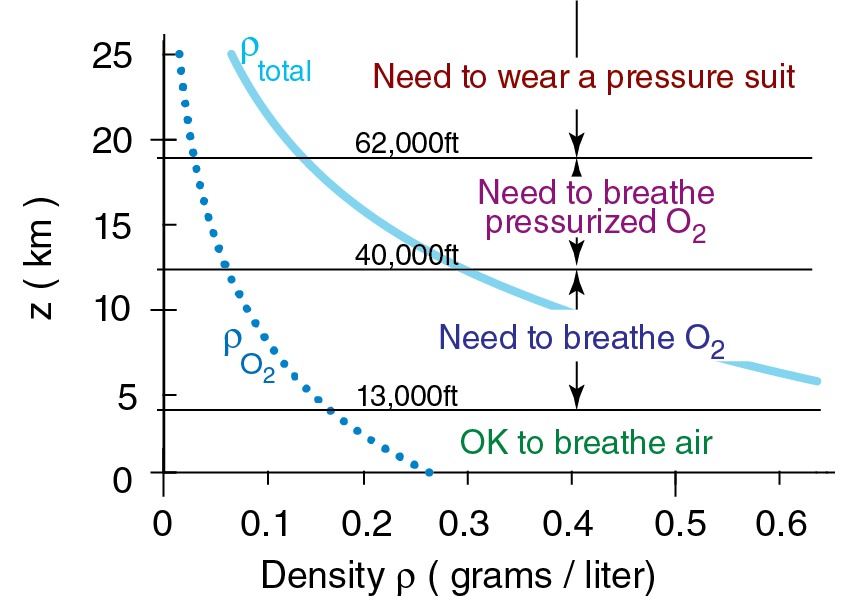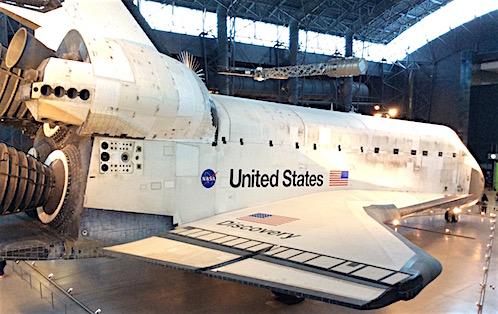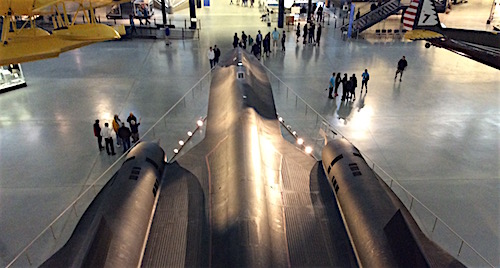ATSC 113 Weather for Sailing, Flying & Snow Sports
Altitude and Pilot Physiology
Learning Goal 2b. Explain how reduced oxygen and/or high altitude affects pilot physiology
Physiology is how your body, and body parts, work. https://www.youtube.com/watch?v=nkfunphAKqo
Breathing air at sea level
Adult humans inhale between 0.5 to 3.0 liters of air with each breath. This volume depends on the physical size of your lungs and your health, so as healthy adults we are stuck with that number. Let's assume a nominal value of 1 liter as a nice round number for lung capacity.
According to the standard atmosphere at sea level, the air density is 1.225 grams / liter. But only 21% of the air is oxygen. So that means that with each breath, we inhale about 0.26 grams of oxygen at sea level!
Imagine getting in an airplane and flying to higher altitudes. By about 4 km (≈ 13,000 ft) altitude above sea level, the total air density (ρ) has decreased to about 0.82 grams / liter, of which there is only about 0.17 grams of oxygen / liter. So now each full breath (still inhaling a fixed volume of 1 liter) is bringing in only about 0.17 grams of oxygen. Quite a bit less than the 0.26 grams of oxygen you could inhale at sea level. At about 4 km (≈ 13,000 ft) altitude, the air is so thin that healthy humans start to become goofy.
— Light blue solid line: change of total air
density (ρtotal)
with altitude (z). This is the same density curve from Learning Goal
10a, but zoomed into its lower left corner. Dotted medium blue line:
change of oxygen partial density (ρO2) with altitude (z). ft = feet.
Hypoxia
The medical term for goofy is hypoxic — namely, suffering from an insufficient supply of oxygen. Nonethess, our behavior is goofy. We can't think straight. We can't concentrate. We start to get euphoric (happy). We are enjoying life — forgetful that we still need to fly the airplane. If we stay at this altitude and breathe this air, we will eventually become unconscious — not a good thing for a pilot.
The higher altitude you fly, the shorter your time-duration of useful consciousness (TUC), as given in the table below. By "useful consciousness", we mean when you can still make reasonable piloting and life-saving decisions. Beyond that time, you might still be conscious, but you are so goofy that you either make poor decisions or make no decisions. With extended periods of time, you may lose consciousness and eventually die due to lack of oxygen.
| Altitude (feet) | Altitude (km) | TUC (time before goofiness) |
|---|---|---|
| 18,000 | 5.5 | 20 - 30 minutes |
| 25,000 | 7.6 | 3 - 5 minutes |
| 30,000 | 9.1 | 1 - 2 minutes |
| 35,000 | 10.7 | 30 - 60 seconds |
| 40,000 | 12.2 | 15 - 20 seconds |
| 50,000 | 15.2 | 9 - 12 seconds |
I was lucky to experience simulated high altitudes in the FAA altitude chamber in Oklahoma, USA. It is a large, sealed room where they can suck out most of the air to simulate various altitudes. In the room are seats with nearby oxygen masks. While we are wearing the oxygen masks, they suck out the air from the room. Then they have us take off our masks to see how quickly be become goofy.
I was amazed how quickly I became goofy. At a simulated altitude of 25,000 ft, I could not remember how to add 2 + 1. But after a short while, I didn't care. Luckily, there are safety personel in the room to put your oxygen mask back on for you.
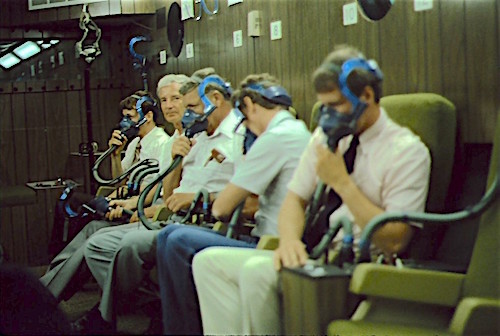
— Altitude chamber
Aside: Commercial Airlines
Modern commercial airlines fly at about 35,000 ft altitude. According to the table above, all the passengers should have been goofy within a couple minutes of reaching the high altitudes. Why aren't they?
The reason is that the airplane has a pressurized cabin. Most older aircraft pressurize the cabin to mimic an altitude of roughly 7,500 to 8,000 feet where the air is dense enough to have sufficient oxygen. Most of us aren't too goofy at that altitude. Some of the new aircraft (e.g., Boeing 787) have a higher cabin pressure to mimic a lower (safer) altitude of 6,000 ft.
For those who have flown on commercial airline flights and listened to the safety briefing, recall that the flight attendants tell you what to do if the cabin has a rapid decompression (such as when a cargo door blows out). They tell you to put your own mask on first, before assisting others around you, such as small children. This is very important — if you try to do it in the opposite order (putting your child's mask on first before your own mask), then you could become unconscious before you get the mask on the child. The result is that both you and your child become unconscious and possibly die. However, if you quickly put your own mask on first, then you will remain conscious and can put a mask on the child. You both live happily ever after.
If there is a rapid decompression of the cabin, the pilot will intentionally point the nose of the aircraft down, and dive at high speed to lower altitudes. She does this not because she has lost control of the aircraft. She dives to lower altitude because she knows that there is not enough oxygen onboard to supply all the passengers for more than a few minutes. She is trying to descend quickly to an altitude where the outside air is dense enough that the passengers can start breathing normal air before the oxygen tanks become empty.
See a YouTube video of a rapid depressurization and an emergency descent simulation: https://www.youtube.com/watch?v=F61cO1k6-W0
What are some of the symptoms of hypoxia?
Between 12,000 and 15,000 feet:
- Impaired/reduced: judgement, memory, alertness, coordination, and ability to make calculations.
- Headache, drowsiness, dizziness, euporia (happy, carefree), or belligerence (want to start a fight).
Above 15,000:
- Periphery vision fails (becomes grayed out), leaving you with tunnel vision.
- Your lips and fingernails become blue (called cyanosis)
- Eventually unconsciousness and then death.
These symptoms happen more quickly at higher altitudes.
Solutions to allow flight at high altitudes
Flight above 13,000 ft
To fly above 13,000 feet and avoid hypoxia, pilots can wear an oxygen mask to breathe from oxygen tanks on the aircraft. On pure oxygen at 13,000 ft (≈ 4 km) altitude, each breath would bring in about 0.82 g of oxygen. That is even greater than the amount in air at sea level. We don't need that much oxygen, so many oxygen systems mix some outside air with the oxygen. However, as you climb to even higher altitudes, you will eventually need to breathe pure oxygen to avoid becoming goofy.
Flight above 40,000 ft
At about 40,000 ft altitude (12.2 km), even breathing pure oxygen does not put enough oxygen in our lungs for us to survive. We still can take a deep breath and fill our lungs (still 1 liter capacity), but we are filling them with oxygen at such a low density (because oxygen density is nearly equal to the air density outside of the oxygen mask) that there are too few oxygen molecules to keep us alive.
To avoid hypoxia, the solution at 40,000 feet and above is to use a mask with a pressurized supply of oxygen.
I tried this once — it was a weird and unpleasant experience. The oxygen gas is forced into your lungs, which tries to inflate you like a balloon. To exhale, you must squeeze hard with your chest and diaphragm muscles to force the used gases out of your lungs against the pressure of the oxygen system. The reason why this works to keep you from getting goofy is that the higher-pressure oxygen in your lungs also has higher density, so there are enough grams of oxygen to keep you conscious and alert.
Flight above 62,000 ft
Above this altitude, a completely different problem happens — your bodily fluids begin to boil.
Perhaps you already know that when boiling foods at high altitude on a mountain or plateau, you need to boil the food a longer period of time in order to get the correct doneness. The reason is that at higher altitude, water boils at a lower temperature. For example, at sea level where air pressure is about 100 kPa (see Learning Goal 2a), fresh water boils at 100°C. But at altitude 2 km (≈6,500 ft), water boils at 93.2°C. Therefore, the food doesn't cook as fast at 93.2°C as it does at 100°C.
As you go to higher altitudes, the boiling temperature continues to decrease. At an altitude of 62,000 ft (≈ 19 km), the atmospheric pressure is about 6.3 kPa — a pressure so low that boiling temperature is 37°C. But human body temperature is about 37°C. Thus, moisture in your lungs and saliva in your mouth will begin to boil at your normal body temperature (i.e., your saliva will fizz, even though your saliva temperature is not hot). This altitude is called the Armstrong altitude or the Armstrong limit. Your blood won't boil yet, because if your heart is pumping then you still have blood pressure that is greater than the ambient environment pressure.
The solution to this problem is to wear a pressure suit. Namely, a
space suit where the whole suit is pressurized to prevent you from
boiling over.
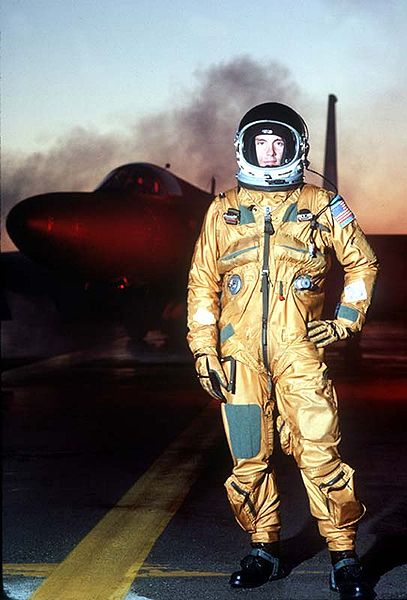
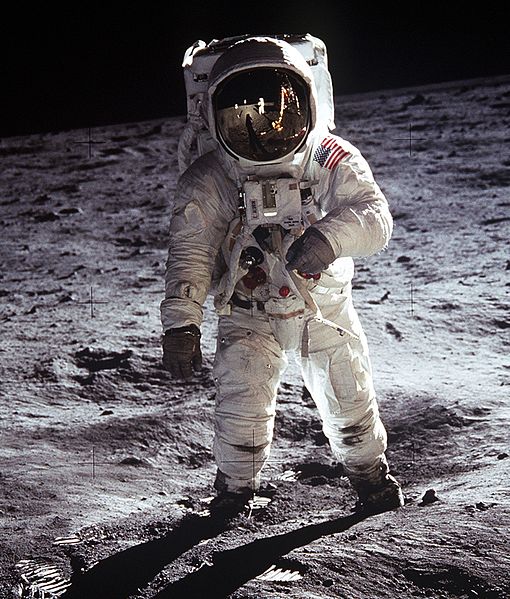
First figure: courtesy of USAF, via https://commons.wikimedia.org/wiki/File:U-2-pilot-suit-up.jpg .
Second figure: courtesy of NASA, via https://commons.wikimedia.org/wiki/File:Apollo_Moonwalk2.jpg .
This is why astronauts on the space shuttle (first photo below) and pilots of high-altitude aircraft (U-2 at 70,000 ft; and SR-71 at 85,000 ft, second photo below) wear space suits in case their cabin pressurization fails.
The next YouTube videos show pilots of these high-altitude aircraft wearing space suits:
- U-2
aircraft. (you might want to view just the first 2
minutes, or play the video at twice normal speed)
- SR-71
aircraft. (the last half of the video shows views in the cockpit)
Key words: physiology, hypoxic, time-duration of useful consciousness (TUC), Armstrong altitude, Armstrong limit
Extra info for experts; not needed for this course.
- YouTube video on proper use of pilot oxygen masks: https://www.youtube.com/watch?v=jba8AcEah1Q .
- FAA Introduction to Aviation Physiology. Section 3 on Hypoxia and other sections.
- AOPA info about oxygen masks for pilots.
- Free NASA eBook on the history of pressure suits: Dennis R. Jenkins, 2012: "Dressing for Altitude". ISBN 978-0-16-090110-2.
- The International Standard Atmosphere (ISA): Wikipedia.
- The US Standard Atmosphere: Wikipedia.
- The US Naval Research Lab atmosphere model from the ground to space, for estimating air drag on satellites: Wikipedia
Image credits. All the photos were taken by Roland Stull, and the drawings were made by Roland Stull, and all are copyright by him and used with his permission.
